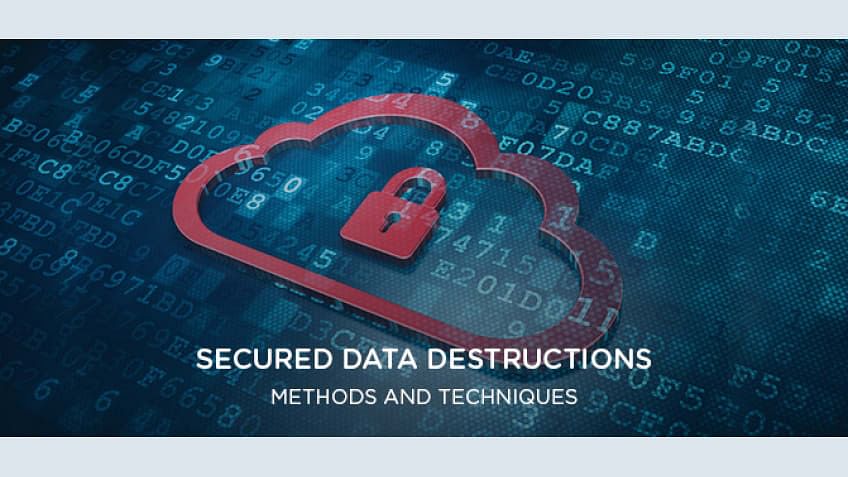The Effect of Effective Data Destruction on Cyber Security Threat Monitoring
The Effect of Effective Data Destruction on Cyber Security Threat Monitoring
Blog Article
Checking Out the Relevance of Information Devastation in the Context of Computer System Safety Providers and Protecting Confidential Information
In a period where data breaches are significantly common, the relevance of reliable data devastation can not be overstated. What methods can organizations execute to improve their data destruction procedures?
Comprehending Data Damage
Information devastation is a critical component of computer security that entails the irreversible removal of data from storage devices to stop unauthorized access and potential data breaches. In an increasingly digital landscape, organizations face heightened risks related to delicate details being poorly accessed or manipulated. Efficient data destruction safeguards versus these hazards, making certain that personal dataâEUR" such as client information, copyright, and financial recordsâEUR" can not be recovered after disposal.
Recognizing the value of information devastation prolongs beyond plain conformity with legal and regulatory frameworks; it is important for maintaining business honesty and count on. When data is improperly handled or improperly ruined, the consequences can be extreme, including monetary loss, reputational damage, and legal liabilities.

Techniques of Data Removal

One widespread approach is information cleaning, which entails overwriting existing information with arbitrary patterns numerous times. This strategy renders the original data irretrievable, making it a popular choice for companies seeking to safeguard secret information.
Another method is degaussing, which utilizes a powerful electromagnetic field to disrupt the magnetic domains on storage space gadgets, properly removing the data. This approach is particularly reliable for magnetic media yet is not relevant to solid-state drives.
Physical damage is one more robust approach, including the shredding or crushing of storage devices. This method assurances that data recovery is virtually difficult, making it perfect for highly delicate info.
Finally, encryption can offer as a corresponding method to data removal. By securing data before deletion, companies can include an extra layer of protection, guaranteeing that also if remnants are recouped, they stay inaccessible without the decryption key. Each approach ought to be picked based on the level of information sensitivity and the certain safety and security needs of the organization.
Legal Compliance and Information Safety And Security
Organizations must browse a complex landscape of legal needs connected to data safety, especially after applying methods of information elimination. Different laws, such as the General Data Security Guideline (GDPR) and the Medical Insurance Transportability and Accountability Act (HIPAA), impose rigid standards on just how organizations must get rid of and handle of sensitive data. Failing to comply with these guidelines can bring about significant legal consequences, consisting of substantial fines and reputational damage.
Data destruction processes must be meticulously documented to demonstrate compliance with appropriate laws and requirements. This documentation not only acts as proof of adherence to legal responsibilities however also illustrates a commitment to protecting sensitive information. Organizations should additionally establish clear policies regarding information retention and devastation timelines, making sure that data is not held longer than essential.

Additionally, regular audits and evaluations of information destruction techniques are crucial to maintain conformity and adjust to developing lawful structures (data destruction). By proactively attending to legal demands, organizations can alleviate risks related to information breaches and show their dedication to data safety. Ultimately, focusing on legal compliance in information devastation processes is not just a governing commitment, but a fundamental aspect of a durable information protection approach
Influence On Business Online Reputation
The online reputation of an organization can be significantly influenced by its approach to data devastation and monitoring. In today's digital landscape, where information violations can happen anytime, the failing to properly deal with delicate information can lead to extreme repercussions. Organizations that improperly take care of information destruction risk subjecting personal client information, which not just goes against privacy legislations yet also wears down trust fund amongst stakeholders and customers.
A damaged reputation can cause decreased customer commitment, as clients end up being reluctant to involve with a company that has shown negligence in protecting their information. Adverse promotion surrounding an look at this now information violation can have a long-term result, as potential customers may be prevented by the perceived lack of safety. This can cause a direct decrease in revenue and market share.
In addition, companies that focus on information destruction as part of their safety technique can boost their reputation by showcasing their commitment to safeguarding sensitive details. By taking on rigorous information management this hyperlink techniques, organizations can not only mitigate risks however also position themselves as reliable entities in their particular industries, thus strengthening their overall brand name image.

Best Practices for Secure Disposal
Carrying out ideal methods for safe disposal of information is vital for alleviating risks connected with data breaches and making certain conformity with privacy regulations. Organizations ought to adopt a comprehensive data disposal policy that lays out treatments for both digital and physical data damage.
For physical information storage devices, such as disk drives, shredding or degaussing is advised to avoid information healing. Additionally, companies should preserve a chain of guardianship documents during the disposal procedure, making certain responsibility and traceability of disposed products.
For digital information, utilizing software program that follows sector criteria for data cleaning is crucial. This software program should overwrite existing information numerous times, making recuperation practically difficult. It is additionally essential to verify the effectiveness of the information destruction procedure through audits or third-party evaluations.
Training workers on safe disposal techniques adds an additional layer of safety, as human mistake can often cause information direct exposure. On a regular basis evaluating and upgrading disposal policies makes certain placement with progressing policies and technological advancements. By executing these ideal techniques, organizations can significantly lower the threat anchor of unapproved data accessibility and boost their total data protection technique.
Final Thought
In verdict, data devastation is a basic facet of computer protection solutions that makes sure the security of personal info from unapproved access. Implementing reliable methods of information eradication, adhering to lawful compliance, and acknowledging the effect on organization online reputation are important components of an extensive data safety approach. By adopting finest techniques for safe disposal, companies can promote depend on with customers and secure delicate information, ultimately adding to a more protected electronic landscape.
In an era where information violations are progressively typical, the significance of effective information devastation can not be overstated.Information damage is a vital element of computer safety and security that entails the irreversible removal of information from storage gadgets to avoid unapproved gain access to and prospective information breaches. Organizations needs to additionally develop clear policies concerning information retention and devastation timelines, making certain that data is not held longer than essential.
By proactively resolving lawful demands, companies can mitigate risks connected with data violations and demonstrate their dedication to data protection (data destruction). Ultimately, focusing on lawful compliance in information damage processes is not simply a regulative obligation, however a fundamental aspect of a robust data safety and security strategy
Report this page